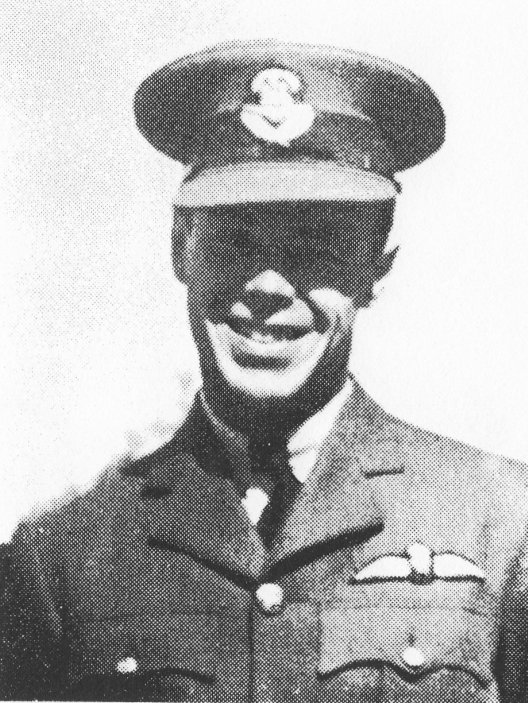419 Squadron First Tour
On May 17th 1942 then P/O Burton Jost was posted to 419 Squadron along with his crew.Navigator P/O Thompson
WAG Sgt. Johnston
A/G F/S Cassidy
A/G Sgt Hart
From May30 until September 1st he and his crew completed what appears to be 19 ops.
On Sept.20 he was posted to No.22 OTU as an instructor, beginning his duties on the 29th
419 Squadron Second Tour
F/L Jost returned to 419 Squadron on June 12th 1943 and took command of "A" Flight.
His crew on consisted of:
Navigator Sgt. B Pope
B/A F/S A.W.A. Bruce
WAG F/O R.O.E. Goodwin
F/E Sgt. J.B. Johnson
A/G Sgt. L Barker
A/G Sgt. R.C. Austen
The crew were on their third operation together when the Halifax serial number JD147 was lost.
During his first Tour with 419 he was introduced to King George during his visit. He was also awarded the DFC on November 2nd. 1942 for his actions during the time on Wellingtons with 419.

Late in the evening of June 25th 1943 at approximately 23:01 hours 419 squadron ID VR-C took off from their base at Middleton St. George with crew members listed as F/L B.N. Jost ( later Squadron Leader) as Captain, Sgt. E.B. Pope as Navigator, F/S A.W. Bruce (RNZAF)as Bomb Aimer, F/O R.O. Goodwin as WAG Sgt. J.D. Johnson as Flight Engineer, F/S L. Barker as Second Gunner Sgt. R.H. Austin as Rear Gunner. The Halifax II squadron ID VR-C was to join up with a massive formation of over 600 bombers headed to Wuppertal Germany.
The usual briefings to the crews had laid out the paths to the targets. The flight paths were never a straight run from a bomber's base to target. Many factors came into play with any size operation. The paths were selected to bypass heavily defended areas on the way to the target as well as other factors, including raids that may be going on concurrently near or on the way to the target. The forming of large numbers of bombers in a air of this size also had an impact on the flight paths and timing of arrivals on target So it was that night the crew of JD147 found themselves under attack between Massstricht and Massmechelen Belgium from a Luftwaffe ME110 night fighter from NJG 4 (Nachtjagdgeschwader 4) Damage to the right wing and an engine caused the wing to burst into flame, the pilot F/L Jost put the aircraft in a nose dive in an attempt to extinguish the flames. The fire had spread to the fuselage when the order to bail out was given. The Bomb Aimer Sgt. Bruce left the aircraft near Massbracht, followed by the Rear Gunner Sgt.. Austin who jumped out near Leroppeveld. The aircraft was coming apart as the crew was bailing out and others were preparing to bail out. The pilot F/L Jost had noticed that the path of the aircraft was heading for a populated area and with bombs still on board. He fought to control the aircraft to miss the town. Navigator Sgt.. Pope and the Second gunner F/S Baker had jumped, leaving just Jost, Johnson and Goodwin on board. With an altitude of only 900 feet F/O Goodwin finally bailed out. All the time on the way to the crash landing parts of the aircraft had been tumbling down to the ground. The aircraft crashed down in a field which locally was called Hammerveld where the separated section of the cockpit section was located by local fire fighters. There the bodies of F/L Jost and Sgt. Johnson were found. German Army units worked at rounding up the crew members that had jumped. With the exception of F/O Goodwin who had been badly hurt in fall, belived to be the failure of his chute to open in time to save him. Local reports gave witness to the fact that F/O Goodwin had lived after the fall and could be heard crying out for help. For some unwritten reason help never came, F/O Goodwin's body was found a number of weeks after the crash From a translation of the article done in the 1980's one part of the fuselage landed at where the TV tower in the photo is now located and the other remaining section, the cockpit area was in a field close by. There are other versions where the bombs had been jetisoned, others where the smaller incentary bombs were still on board. Either way the Flight Enginneer and the Pilot knew they had to stay with JD146 to miss hitting the village. The people of Roermond named this road after S/L Jost and included a memorial stone with the names of S/L Jost and Sgt. Johnson. The stone also includes the squadron number and the aircraft serial number.

